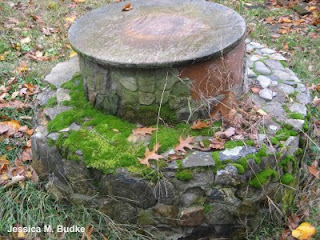I had a great time at the foray this past weekend! There were approximately 20 amateurs and professionals who came to study the lichens and mosses of northeastern Connecticut. I ran into an old friend who I hadn’t seen in years and I met some new folks who I hope to see in the future.
Over the course of the weekend we explored three different sites: Boston Hollow in the Yale Meyer’s Forest near Westford, Cat Den Swamp in the Natchaug State Forest near Eastford, and an area of the Windham Bog. (I didn’t make it to the last site due to a previous commitment, but that is where they said they were going.) The weekend weather was perfect! A little cool with the snap of the coming fall in the air and crisp blue skies overhead.
The first site was identified by the lichenologists as a talus slope with a wet seepy area near the road. I had to ask for the definition of talus and was told that it is a fancy word for a pile of rocks at the base of a cliff or slope. They were pretty big rocks and I probably would have called them boulders, but tallus works well too. Being out in the field with bryologists who can identify more plants than I can was a little intimidating, but it also resulted in my learning to recognize a number of new species in the field.
I spent most of my time acting as a sponge absorbing information and only took a few photos. Unfortunately when I went back to pick some to put up with this post I was disappointed to find some really fuzzy photos and only a couple that are even close to in focus. Despite that I will post a few up here for a splash of green and give you some description of them below.



Above center is some Mniaceae. (the 'M' is silent in the pronunciation) The leaves are whirled into a splash cup that is filled with male sex organs (antheridia). To the above-right is a very small moss whose spore filled capsules are not elevated on a stalk. Thus they appear to be sitting directly on the soil. This is a member of the genus Diphyscium. The above-left is a common genus that I often see in Connecticut forests, but a new species for me. It is Thuidium minutulum. I love the name. It means the miniature Thuidium and that is just what it looks like. A very small slender version of the robust Thuidium that I often see covering rocks or soil in Connecticut.
A special thanks goes out to Juan Sanchez who organized the trip and lodging.
I will have another story about the foray later this week or next. Stay tuned for more mosses...










































